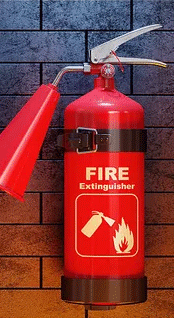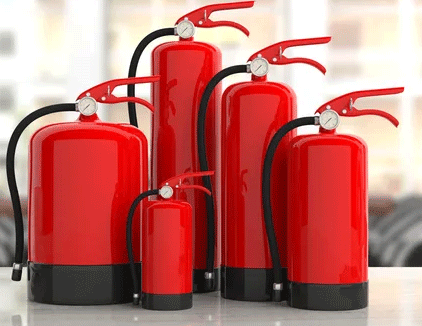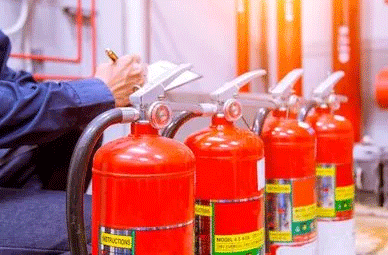Synthetic foam fire extinguisher, Foam fire extinguisher
Synthetic Foam Fire Extinguishers, also known as Foam Extinguishers, Foam fire extinguishers have undergone a major change over the years. Initially they have a thick and glossy texture. The foams are quite smelly due to the high animal protein content used. In contrast, modern Aqueous Film Forming Foam (AFFF) is more and more developed and advanced. It provides a more effective solution when it comes to extinguishing fires.
Synthetic foam fire extinguishers, Foam fire extinguishers are usually indicated by a blue band above the instructions. It is designed to extinguish class A and B fires. Class A includes fires caused by or involving certain materials, including rubber, various plastics, textiles, paper and wood . On the other hand, class B includes flammable liquids. Synthetic foam fire extinguishers come in a variety of sizes to suit different applications and requirements.

Bình chữa cháy bọt tổng hợp, bình chữa cháy Foam
How foam fire extinguishers work
- Synthetic foam fire extinguishers extinguish fires by covering the fire with a thick layer of foam. In turn, this deprives the fire of oxygen supply, thereby impairing its ability to release flammable vapors. When directed towards a flammable liquid, the foam allows the liquid to escape from it before forming a water film. This creates ideal conditions to effectively block fuel vapors and seal the liquid surface.
- Traces of water in the foam enhance containment by creating a cooling effect. However, these fire extinguishers are not effective in dealing with fires associated with deep fat fryers.
- Aqueous film forming foam (AFFF) leverages the fire suppression power of hydrocarbon and fluorosurfactant technologies to provide superior fire suppression. Foam also uses multiple mechanisms designed to ensure burn resistance. It also boasts superior wetting properties and can be used with other chemical agents such as dry violet-K compounds to provide improved fire suppression performance.
- Anti-alcohol foam comes with a polymer that provides a protective layer between the foam and the flame surface. This is intended to combat foam decomposition, often caused by the presence of alcohol in the burning liquid. Alcohol-resistant foam is more effective in extinguishing hydrogen peroxide fires.
Rq expansion rate of synthetic foam
- Low-expansion foams such as Aqueous Film-Forming Foam (AFFF) have high mobility allowing them to cover large areas. They also have low viscosity properties and an expansion rate of less than 20.
- The expansion ratio of expanding firefighting foam averages between 20 and 100.
- Highly expanding foams are suitable for use in enclosed spaces because they have the ability to quickly fill the fire area. They have expansion rates ranging from 200 to 1000.
>>> What is the feature diagram of the high expansion coefficient foam system? >>>
Features of synthetic foam fire extinguishers
- Affordable and easy to maintain
- Highly mobile
- Foam fire extinguisher can be recharged
- Effective on Class A and B flames
- They come with all-metal valves, steel cylinders and nozzles
- Available in pressure and stored tank models

Types of synthetic foam fire extinguishers
- Synthetic foam is manufactured using synthetic surfactants to ensure better flow. This allows the fire extinguisher foam to achieve a much faster extinguishing effect as it spreads over hydrocarbon-based liquids. However, this variant can contaminate groundwater sources and limit security after a fire. Aqueous film-forming foam (AFFF) and alcohol-resistant film-forming foam (AR-AFFF) fall into this category.
- Unlike synthetic variants, protein foams typically flow and spread at a slower rate. However, they are more durable and heat resistant. These foams are made from natural proteins and they are environmentally friendly thanks to their biodegradable properties. Some types of foam that fall under this classification include:
+ Fluoroprotein (AR-FFFP).
+ Foam fluoroprotein (FP)
+ Foam fluoroprotein (AR-FP)
+ Foam protein (P)
+ Fluoroprotein (FFFP)

Aqueous film forming foam (AFFF)
AFFF foam is available in a variety of grades, including AFFF 3% Plus, AFFF 1% F, AFFF 3% ICAO and many others. AFFF 1% A is often mixed with a number of solvents, stabilizers and preservatives. Foam should be used at a 1 percent solution (that's 99 parts water and 1 part concentrate). Sea water, brackish water or fresh water can be used for this purpose.
>>> Foam structure with high expansion coefficient >>>>

Have 0 comment, evaluate about Synthetic foam fire extinguisher, Foam fire extinguisher
TVAdministratorsAdministrators
Welcome, honored guests. Please leave a comment, we will respond soon